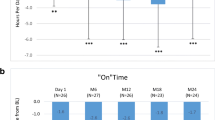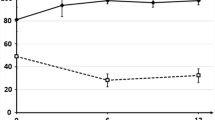Abstract
Introduction
Immediate-release (IR) amantadine has been marketed for Parkinson’s disease (PD) therapy for 50 years, while two novel extended-release formulations have only recently reached the market in the US.
Objectives
The aim of this study was to describe amantadine IR utilization patterns in the French COPARK cohort, at baseline and after 2 years of follow-up.
Methods
Overall, 683 PD patients from the COPARK survey were evaluated. All patients were assessed in a standardized manner (demographics, treatments, Unified Parkinson’s Disease Rating Scale [UPDRS], Hospital Anxiety and Depression Scale, Pittsburg Questionnaire and health-related quality-of-life scales (Short Form-36 [SF-36], 39-item Parkinson’s Disease Questionnaire [PDQ-39]). Longitudinal data were only available for 401/683 patients (59%) with a median (P25–75) follow-up period of 23 months (18–31). Patients were assessed in the same way as in the baseline visit.
Results
At baseline, amantadine was prescribed to 61/683 (9%) patients (median dose 200 mg/day, range 100–300 mg/day). Amantadine was initiated after a median of 7 years from PD diagnosis, and its prescription was correlated with the presence of dyskinesia (logistic regression odds ratio [OR] 3.72, 95% confidence interval [CI] 1.95–7.08) and hallucinations (UPDRS I.2) [OR 1.57, 95% CI 1.08–2.29]. After 2 years, the amantadine prescription increased from 33 (8%) patients at baseline to 54 (14%) patients in the subset of 401 patients analysed twice (p = 0.001). Among the 33 patients receiving amantadine at baseline, 9 (27%) stopped amantadine, 5 (15%) increased the dose, 6 (18%) reduced the dose and 13 (40%) stayed at the same doses. Treatment was initiated in 30/54 new patients (55%). Patients who started amantadine or increased its dose (n = 35) had more levodopa-induced dyskinesias at baseline (OR 7.02, 95% CI 3.09–15.90) and higher Mini-Mental State Examination score at follow-up (OR 1.37, 95% CI 1.06–1.79). Undergoing deep brain stimulation was related to stopping or downtitrating amantadine (OR 22.02, 95% CI 4.24–114.44; n = 15).
Conclusions
In this cohort, amantadine was used in 10% of patients. Its use increased during follow-up, despite the fact that one-third of patients who received amantadine at baseline stopped taking it. Amantadine prescription was mainly correlated with the presence of dyskinesia.

Similar content being viewed by others
References
Schwab RS, England AC Jr, Poskanzer DC, et al. Amantadine in the treatment of Parkinson’s disease. JAMA. 1969;208:1168–70.
Perez-Lloret S, Rascol O. Efficacy and safety of amantadine for the treatment of L-DOPA-induced dyskinesia. J Neural Transm (Vienna). 2018;125:1237–50.
Chase TN, Oh JD. Striatal dopamine- and glutamate-mediated dysregulation in experimental parkinsonism. Trends Neurosci. 2000;23:S86–91.
Huot P, Johnston TH, Koprich JB, et al. The pharmacology of L-DOPA-induced dyskinesia in Parkinson’s disease. Pharmacol Rev. 2013;65:171–222.
Verhagen Metman L, Del Dotto P, Blanchet PJ, et al. Blockade of glutamatergic transmission as treatment for dyskinesias and motor fluctuations in Parkinson’s disease. Amino Acids. 1998;14:75–82.
Verhagen Metman L, Del Dotto P, van den Munckhof P, et al. Amantadine as treatment for dyskinesias and motor fluctuations in Parkinson’s disease. Neurology. 1998;50:1323–6.
Snow BJ, Macdonald L, McAuley D, et al. The effect of amantadine on levodopa-induced dyskinesias in Parkinson’s disease: a double-blind, placebo-controlled study. Clin Neuropharmacol. 2000;23:82–5.
Ory-Magne F, Corvol JC, Azulay JP, et al. Withdrawing amantadine in dyskinetic patients with Parkinson disease: the AMANDYSK trial. Neurology. 2014;82:300–7.
Fox SH, Katzenschlager R, Lim SY, et al. International Parkinson and movement disorder society evidence-based medicine review: Update on treatments for the motor symptoms of Parkinson’s disease. Mov Disord. 2018;33:1248–66.
Pahwa R, Tanner CM, Hauser RA, et al. ADS-5102 (Amantadine) extended-release capsules for levodopa-induced dyskinesia in parkinson disease (EASE LID Study): a randomized clinical trial. JAMA Neurol. 2017;74(8):941–9.
Pahwa R, Tanner CM, Hauser RA, et al. Amantadine extended release for levodopa-induced dyskinesia in Parkinson’s disease (EASED Study). Mov Disord. 2015;30(6):788–95.
Oertel W, Eggert K, Pahwa R, et al. Randomized, placebo-controlled trial of ADS-5102 (amantadine) extended-release capsules for levodopa-induced dyskinesia in Parkinson’s disease (EASE LID 3). Mov Disord. 2017;32(12):1701–9.
Perez-Lloret S, Negre-Pages L, Damier P, et al. Freezing of gait in Parkinson’s disease: prevalence, determinants, and effects on quality of life. JAMA Neurol. 2014;71:884–90.
Rascol O, Perez-Lloret S, Damier P, et al. Falls in ambulatory non-demented patients with Parkinson’s disease. J Neural Transm (Vienna). 2015;122:1447–55.
Fahn S, Elton RL. Unified Parkinson’s Disease Rating Scale. In: Fahn S, Marsden CD, Goldstein M, Calne DB, editors. Recent developments in Parkinson’s disease. Florham Park, NJ: Macmillan Healthcare Information; 1987. p. 153–63.
Folstein MF, Folstein SE, McHugh PR. “Mini-mental state”. A practical method for grading the cognitive state of patients for the clinician. J Psychiatr Res 1975; 12:189–98.
Zigmond AS, Snaith RP. The hospital anxiety and depression scale. Acta Psychiatr Scand. 1983;67:361–70.
Buysse DJ, Reynolds CF 3rd, Monk TH, et al. The Pittsburgh Sleep Quality Index: a new instrument for psychiatric practice and research. Psychiatry Res. 1989;28:193–213.
Ware JE Jr, Sherbourne CD. The MOS 36-item short-form health survey (SF-36). I. Conceptual framework and item selection. Med Care 1992; 30:473–83.
Jenkinson C, Fitzpatrick R, Peto V, et al. The Parkinson’s Disease Questionnaire (PDQ-39): development and validation of a Parkinson’s disease summary index score. Age Ageing. 1997;26:353–7.
Tomlinson CL, Stowe R, Patel S, et al. Systematic review of levodopa dose equivalency reporting in Parkinson’s disease. Mov Disord. 2010;25:2649–53.
Crispo JA, Fortin Y, Thibault DP, et al. Trends in inpatient antiparkinson drug use in the USA, 2001–2012. Eur J Clin Pharmacol. 2015;71:1011–9.
Navarro R, Whangbo A, Pahwa R, et al. An assessment of the persistence and medication possession ratio of adjunctive treatments to levodopa in patients with Parkinson’s disease (PD). Available at: https://www.adamaspharma.com/amcp2017persistence-v03-2/. Accessed 1 Jun 2019.
Jena M, Jena SS, Mishra S, et al. Antiparkinsonian drug utilization pattern and ADR monitoring in a tertiary care teaching hospital: a hospital based observational study. J Pharm Tech Innov. 2016;3:15–22.
Rascol O, Brooks DJ, Korczyn AD, et al. A five-year study of the incidence of dyskinesia in patients with early Parkinson’s disease who were treated with ropinirole or levodopa. 056 Study Group. N Engl J Med 2000; 342: 1484-91.
Kalia LV, Lang AE. Parkinson’s disease. Lancet. 2015;386:896–912.
Deuschl G, Schade-Brittinger C, Krack P, et al. A randomized trial of deep-brain stimulation for Parkinson’s disease. N Engl J Med. 2006;355:896–908.
Acknowledgements
The authors thank the patients who agreed to participate in this study and the Association France-Parkinson for its support. The COPARK study group included Dr. F. Tison (Bordeaux); Dr. E. Gaujard, Dr. E. Puymirat, Dr. A. Lanusse, Dr. C. Delabrousse-Mayoux, Dr. E. Goumard, Dr. M.H. Godin, Dr. P. Damier (Nantes); Dr. P. Lejeune, Dr. B. Philippe, Dr. C. Lanctin-Garcia, Dr. V. Verbist-Talmant, Dr. Rascol (Toulouse); Dr. B. Robinson, Dr. V. Rey-Zermati (Narbonne); Dr. X. Soulages (Rodez); Dr. C. Azais-Vuillemin (Toulouse); N. Stambouli (Cahors); Dr. J.R. Rouane (Toulouse); Dr. A.M. Salandini (Toulouse); Dr. J.M. Boulesteix (Cahors); Dr. M. Barreda (Castres); Dr. D. Castan (Castres); Dr. A. Ojero-Senard (Toulouse); Dr. S. Perez-Lloret (Toulouse); Dr. G. Angibaud (Montauban); Dr. J.P. Balague (Montauban); Dr. A. Danielli (Montauban); Dr. K. Attane (Carcasonne); Dr. J.M. Faucheux (Castres); Dr. P. Henry (Toulouse); Dr. M.G. Rougie (Toulouse); Dr. R. Darmanaden, Dr. B. Jardillier (Figeac); Dr. F. Bonenfant (Toulouse); Dr. Azais (Toulouse); Dr. Damase (Toulouse) and Dr. A. Destee (Lille).
Author information
Authors and Affiliations
Consortia
Corresponding author
Ethics declarations
Funding
This project was co-funded by unrestricted and unconditional grants from the Association France-Parkinson, ADREN, Boehringer Ingelheim, Eisai, Faust Pharmaceuticals, GlaxoSmithKline, Pierre Fabre Médicaments, Solvay Pharma, and Wyeth Lederlé. The project was sponsored and co-financed by LN PHARMA, which participated in the design and conduct of the study; collection, management, and interpretation of the data; and preparation and review of the manuscript.
Conflict of interest
Olivier Rascol has acted as a scientific advisor for drug companies developing antiparkinsonian medications (Abbott, Abbvie, Acorda, Adamas, BIAL, Biogen, Boehringer-Ingelheim, Cynapsus, GSK, Impax, Merck, Osmotica, Oxford-Biomedica, Lundbeck, Novartis, Prexton, Servier, Sunovion, TEVA, UCB and Zambon) and has received unrestricted scientific grants from academic non-profit entities (Toulouse University Hospital, French Health Ministry, MJFox Foundation, France-Parkinson, European Commission). Laurence Negre-Pages reports grants from the Association France-Parkinson, ADREN, Boehringer Ingelheim, Eisai, Faust Pharmaceuticals, GlaxoSmithKline, Pierre Fabre Médicaments, Solvay Pharma and Wyeth Lederlé for funding this project. She also owns stock options from LN PHARMA, which was one of the sponsors of this study. Philippe Damier has received honoraria for conferences from Teva and Novartis. Wassilios Meissner reports receiving a grant from the Bordeaux University Hospital for this project. Outside the present work, he has received fees for editorial activities with Springer, consultancy activities from Affiris, Biohaven, Lundbeck and Sanofi, teaching honoraria from UCB, Boehringer Ingelheim and MDS, and research support from the Michael J Fox Foundation, the University Hospital Bordeaux, the French Health Ministry, the European Community, ANR, ARAMISE, PSP France, MSA Coalition, ARAMISE and LABEX Excellence Initiative. Santiago Perez-Lloret has received honoraria from Osmotica. Arnaud Delval, Pascal Derkinderen, Alain Destée, Margherita Fabbri, Amine Rachdi and Francois Tison have no conflicts of interest to declare.
Additional information
The members for the COPARK Study Group are listed in the Acknowledgements section.
Rights and permissions
About this article
Cite this article
Rascol, O., Negre-Pages, L., Damier, P. et al. Utilization Patterns of Amantadine in Parkinson’s Disease Patients Enrolled in the French COPARK Study. Drugs Aging 37, 215–223 (2020). https://doi.org/10.1007/s40266-019-00740-2
Published:
Issue Date:
DOI: https://doi.org/10.1007/s40266-019-00740-2




